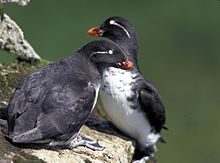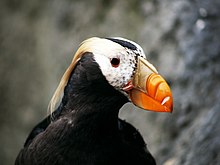Auk
| Auks Temporal range:Late Eocene– recent
| |
|---|---|

| |
| Parakeet auklets(Aethia psittacula) | |
| Scientific classification | |
| Domain: | Eukaryota |
| Kingdom: | Animalia |
| Phylum: | Chordata |
| Class: | Aves |
| Order: | Charadriiformes |
| Suborder: | Lari |
| Family: | Alcidae Leach,1820 |
| Type species | |
| Alca torda | |
| Subfamilies | |
| |
Auksoralcidsare a group ofbirdsof the familyAlcidaein the orderCharadriiformes.[1]The alcid family includes themurres,guillemots,auklets,puffins,andmurrelets.The family contains 25 extant or recently extinct species that are divided into 11 genera. Auks are found throughout theNorthern Hemisphere.[1][2]
Apart from the extinctgreat auk,all auks can fly, and are excellent swimmers and divers (appearing to "fly" in water), but their walking appears clumsy.
Names
[edit]Several species have different English names in Europe and North America. The two species known as "murres" in North America are called "guillemots" in Europe, and the species calledlittle aukin Europe is referred to as dovekie in North America.
Etymology
[edit]The word "auk"/ɔːk/is derived fromIcelandicálkaandNorwegianalkaoralkefromOld NorseālkafromProto-Germanic*alkǭ(sea-bird, auk).[3][4]
Taxonomy
[edit]Thefamilyname Alcidae comes from the genusAlcagiven byCarl Linnaeusin 1758 for therazorbill(Alca torda) from the Norwegian wordalke.[5]
Description
[edit]Auks are superficially similar topenguins,having black-and-white colours, upright posture, and some of their habits. Nevertheless, they are not closely related to penguins, but rather are believed to be an example of moderateconvergent evolution.Auks aremonomorphic(males and females are similar in appearance).
Extant auks range in size from theleast auklet,at 85 g (3 oz) and 15 cm (5.9 in), to thethick-billed murre,at 1 kg (2.2 lb) and 45 cm (18 in). Due to their short wings, auks have to flap their wings very quickly to fly.
Although not to the extent of penguins, auks have largely sacrificed flight, and also mobility on land, in exchange for swimming ability; their wings are a compromise between the best possible design for diving and the bare minimum needed for flying. This varies by subfamily, with theUriaguillemots (including therazorbill) and murrelets being the most efficient under the water, whereas the puffins and auklets are better adapted for flying and walking.
Feeding and ecology
[edit]The feeding behaviour of auks is often compared to that of penguins; both groups arewing-propelled, pursuit divers. In the region where auks live, their only seabird competition arecormorants(which are dive-powered by their strong feet). In areas where the two groups feed on the same prey, the auks tend to feed further offshore. Strong-swimming murres hunt faster, schooling fish, whereas auklets take slower-moving krill. Time depth recorders on auks have shown that they can dive as deep as 100 m (330 ft) in the case ofUriaguillemots, 40 m (130 ft) for theCepphusguillemots and 30 m (98 ft) for the auklets.
Breeding and colonies
[edit]Auks arepelagicbirds, spending the majority of their adult lives on the open sea and going ashore only for breeding, although some species, such as thecommon guillemot,spend a great part of the year defending their nesting spot from others.
Auks are monogamous, and tend to form lifelong pairs. They typically lay a single egg, and theyuse the nesting siteyear after year.
Some species, such as theUriaguillemots (murres), nest in largecolonieson cliff edges; others, such as theCepphusguillemots, breed in small groups on rocky coasts; and thepuffins,auklets, and some murrelets nest in burrows. All species except theBrachyramphusmurrelets are colonial.
Evolution and distribution
[edit]
Traditionally, the auks were believed to be one of the earliest distinct charadriiform lineages due to their characteristicmorphology,but genetic analyses have demonstrated that these peculiarities are the product of strong natural selection, instead; as opposed to, for example,plovers(a much older charadriiform lineage), auks radically changed from a wadingshorebirdto a diving seabird lifestyle. Thus today, the auks are no longer separated in their own suborder (Alcae), but are considered part of theLarisuborder, which otherwise contains gulls and similar birds. Judging from genetic data, their closest living relatives appear to be theskuas,with these two lineages separating about 30million years ago(Mya).[6][7][8]Alternatively, auks may have split off far earlier from the rest of the Lari and undergone strong morphological, but slow genetic evolution, which would require a very highevolutionary pressure,coupled with a long lifespan and slow reproduction.
The earliest unequivocalfossilsof auks are from the lateEocene,some 35 Mya.[9]ThegenusMiocepphus,(from theMiocene,15 Mya) is the earliest known from good specimens. Two very fragmentary fossils are often assigned to the Alcidae, although this may not be correct:Hydrotherikornis(LateEocene) andPetralca(LateOligocene). Most extant genera are known to exist since the Late Miocene or EarlyPliocene(about 5 Mya). Miocene fossils have been found in bothCaliforniaandMaryland,but the greater diversity of fossils and tribes in the Pacific leads most scientists to conclude they first evolved there, and in the Miocene Pacific, the first fossils of extantgeneraare found. Early movement between the Pacific and the Atlantic probably happened to the south (since no northern opening to the Atlantic existed), with later movements across the Arctic Ocean.[10]The flightless subfamilyMancallinae,which was apparently restricted to the Pacific Coast of southern North America and became extinct in the EarlyPleistocene,is sometimes included in the family Alcidae under some definitions. One species,Miomancalla howardae,is the largest charadriiform of all time.[11]

The family contains 25 extant or recently extinct species that are divided into 11 genera.[2]The extant auks (subfamily Alcinae) are broken up into two main groups - the usually high-billed puffins (tribe Fraterculini) and auklets (tribe Aethiini), as opposed to the more slender-billed murres and true auks (tribe Alcini), and the murrelets and guillemots (tribes Brachyramphini and Cepphini). The tribal arrangement was originally based on analyses of morphology andecology.[12]mtDNAcytochromebsequences,andallozymestudies[6][7]confirm these findings except that theSynthliboramphusmurrelets should be split into a distinct tribe, as they appear more closely related to the Alcini; in any case, assumption of a closer relationship between the former and the true guillemots was only weakly supported by earlier studies.[12]
Of the genera, only a few species are placed in each. This is probably a product of the rather small geographic range of the family (the most limited of any seabird family), and the periods ofglacialadvance and retreat that have kept the populations on the move in a narrow band of subarctic ocean.
Today, as in the past, the auks are restricted to cooler northern waters. Their ability to spread further south is restricted as their prey hunting method, pursuit diving, becomes less efficient in warmer waters. The speed at which small fish (which along with krill are the auk's principal prey) can swim doubles as the temperature increases from 5 to 15 °C (41 to 59 °F), with no corresponding increase in speed for the bird. The southernmost auks, in California and Mexico, can survive there because of coldupwellings.The current paucity of auks in the Atlantic (six species), compared to the Pacific (19–20 species) is considered to be because of extinctions to the Atlantic auks; the fossil record shows many more species were in the Atlantic during the Pliocene. Auks also tend to be restricted to continental-shelf waters and breed on few oceanic islands.
Hydotherikornis oregonus(Described by Miller in 1931), the oldest purported alcid from the Eocene of California, is actually a petrel (as reviewed by Chandler in 1990) and is reassigned to the tubenoses (Procellariiformes). A 2003 paper, "The Earliest North American Record of Auk (Aves: Alcidae) From the Late Eocene of Central Georgia", reports a Late Eocene, wing-propelled, diving auk from the Priabonain stage of the Late Eocene. These sediments have been dated through Chandronian NALMA {North American Land Mammal Age}, at an estimate of 34.5 to 35.5 million years on the Eocene time scale for fossil-bearing sediments of the Clinchfield Formation, Gordon, Wilkinson County, Georgia. Furthermore, the sediments containing this unabraded portion of a left humerus (43.7 mm long) are tropical or subtropical as evidenced by a wealth of warm-water shark teeth, palaeophied snake vertebrae, and turtles.
Systematics
[edit]| Cladogram of theAlcidaefamily[9] |
- Basal andincertae sedis
- Miocepphus(fossil:Middle Miocene of CE USA)
- Miocepphus mcclungiWetmore, 1940
- Miocepphus bohaskaiWijnker and Olson, 2009
- Miocepphus blowiWijnker and Olson, 2009
- Miocepphus mergulellusWijnker and Olson, 2009
- Miocepphus(fossil:Middle Miocene of CE USA)
- Subfamily Alcinae
- Tribe Alcini– typical auks and murres

The synthliboramphine Xantus's murrelet (Synthliboramphus hypoleucus) is quite distinct from the brachyramphine murrelets. - Uria
- Common murreor common guillemot,Uria aalge
- Thick-billed murreor, Brünnich's guillemot,Uria lomvia
- Alle
- Little aukor dovekie,Alle alle
- Pinguinus
- Alca
- Razorbill,Alca torda
- Uria
- Tribe Synthliboramphini– synthliboramphine murrelets

Black guillemot(Cepphus grylle,a true guillemot) in summer (front) and winter plumage - Synthliboramphus
- Scripps's murrelet,Synthliboramphus scrippsi– formerly inS. hypoleucus( "Xantus's murrelet")
- Guadalupe murrelet,Synthliboramphus hypoleucus– sometimes separated inEndomychura
- Craveri's murrelet,Synthliboramphus craveri– sometimes separated inEndomychura
- Ancient murrelet,Synthliboramphus antiquus
- Japanese murrelet,Synthliboramphus wumizusume
- Synthliboramphus
- Tribe Cepphini– true guillemots

Marbled murrelet(Brachyramphus marmoratus,a brachyramphine murrelet) in breeding plumage - Cepphus
- Black guillemotor tystie,Cepphus grylle
- Pigeon guillemot,Cepphus columba
- Kurile guillemot,Cepphus columba snowi
- Spectacled guillemot,Cepphus carbo
- Cepphus
- Tribe Brachyramphini– brachyramphine murrelets
- Brachyramphus
- Marbled murrelet,Brachyramphus marmoratus
- Long-billed murrelet,Brachyramphus perdix
- Kittlitz's murrelet,Brachyramphus brevirostris
- Brachyramphus
- Tribe Alcini– typical auks and murres
- Subfamily Fraterculinae
- Tribe Aethiini– auklets

Tufted puffin(Fratercula cirrhata) - Ptychoramphus
- Cassin's auklet,Ptychoramphus aleuticus
- Aethia
- Parakeet auklet,Aethia psittacula
- Crested auklet,Aethia cristatella
- Whiskered auklet,Aethia pygmaea
- Least auklet,Aethia pusilla
- Ptychoramphus
- Tribe Fraterculini– puffins
- Cerorhinca
- Rhinoceros auklet,Cerorhinca monocerata
- Fratercula
- Atlantic puffin,Fratercula arctica
- Horned puffin,Fratercula corniculata
- Tufted puffin,Fratercula cirrhata
- Cerorhinca
- Tribe Aethiini– auklets
Biodiversityof auks seems to have been markedly higher during the Pliocene.[10]See the genus accounts for prehistoric species.
See also
[edit]- Kiviak,a traditional Inuit food from Greenland that is made of auks preserved in seal skin
- Tradeoffs for locomotion in air and water
References
[edit]- ^abMyers, P.; Espinosa, R.; Parr, C. S.; Jones, T.; Hammond, G. S.; Dewey, T. A. (2022)."Alcidae".Animal Diversity Web.University of Michigan Museum of Zoology.Retrieved31 December2022.
- ^abGill, Frank;Donsker, David;Rasmussen, Pamela,eds. (August 2022)."Noddies, gulls, terns, skimmers, skuas, auks".IOC World Bird List Version 12.2.International Ornithologists' Union.Retrieved10 November2022.
- ^"Definition of Auk".Merriam-Webster.
- ^"Definition of auk".Dictionary.com.
- ^Jobling, James A. (2010)."Alca"(PDF).The Helm Dictionary of Scientific Bird Names.London, United Kingdom: Christopher Helm. p. 40.ISBN978-1-4081-2501-4.
- ^abFriesen, V.L.; Baker, A.J. & Piatt, J.F. (1996)."Phylogenetic Relationships Within the Alcidae (Charadriiformes: Aves) Inferred from Total Molecular Evidence".Molecular Biology and Evolution.13(2): 359–367.doi:10.1093/oxfordjournals.molbev.a025595.PMID8587501.
- ^abMoum, Truls; Arnason, Ulfur & Árnason, Einar (2002)."Mitochondrial DNA Sequence Evolution and Phylogeny of the Atlantic Alcidae, Including the Extinct Great Auk (Pinguinus impennis) ".Molecular Biology and Evolution.19(9): 1434–1439.doi:10.1093/oxfordjournals.molbev.a004206.PMID12200471.
- ^Thomas, Gavin H.; Wills, Matthew A. & Székely, Tamás (2004)."A supertree approach to shorebird phylogeny".BMC Evolutionary Biology.4(1): 28.doi:10.1186/1471-2148-4-28.PMC515296.PMID15329156.Supplementary Material
- ^abSmith, N.A. (2011)."Taxonomic revision and phylogenetic analysis of the flightless Mancallinae (Aves, Pan-Alcidae)".ZooKeys(91): 1–116.Bibcode:2011ZooK...91....1S.doi:10.3897/zookeys.91.709.PMC3084493.PMID21594108.
- ^abKonyukhov, N.B. (2002). "Possible Ways of Spreading and Evolution of Alcids".Biology Bulletin of the Russian Academy of Sciences(in Russian).29(5): 447–454.doi:10.1023/A:1020457508769.S2CID36133751.
- ^Smith, N. A. (2015). "Evolution of body mass in the Pan-Alcidae (Aves, Charadriiformes): the effects of combining neontological and paleontological data".Paleobiology.42(1): 8–26.doi:10.1017/pab.2015.24.S2CID83934750.
- ^abStrauch J.G. Jr. (1985)."The phylogeny of the Alcidae"(PDF).The Auk.102(3): 520–539.doi:10.1093/auk/102.3.520.JSTOR4086647.
Further reading
[edit]- Collinson, Martin (2006)."Splitting headaches? Recent taxonomic changes affecting the British and Western Palaearctic lists".British Birds.99(6): 306–323.
- Gaston, Anthony J.; Jones, Ian L. (1998).The Auks: Alcidae.Oxford: Oxford University Press.ISBN0-19-854032-9.
- Paton, T.A.; Baker, A.J.; Groth, J.G.; Barrowclough, G.F. (2003). "RAG-1 sequences resolve phylogenetic relationships within charadriiform birds".Molecular Phylogenetics and Evolution.29(2): 268–278.Bibcode:2003MolPE..29..268P.doi:10.1016/S1055-7903(03)00098-8.PMID13678682.
- Diving Birds of North AmericabyPaul Johnsgard
External links
[edit] Media related toAlcidaeat Wikimedia Commons
Media related toAlcidaeat Wikimedia Commons- .Encyclopædia Britannica.Vol. III (9th ed.). 1878. p. 85.
